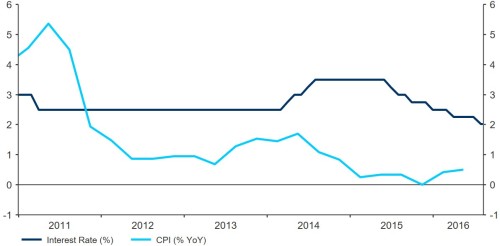US Dollar weakens for second day, New Zealand interest rate cut to record low
- Go back to blog home
- Latest
The US Dollar was sold-off against its major peers for the second day in a row on Wednesday with last Friday’s gains now effectively wiped out as the euphoria surrounding the strong nonfarm payrolls report for July wears off.
Sterling’s recovery was short lived yesterday with the currency falling back to its one month low against the US Dollar this morning following the release of some soft housing data. The Euro meanwhile rallied again on Wednesday, inching towards the 1.12 level against the USD for the first time in a week. With no economic announcements in the Euro-area, the single currency was driven almost exclusively by general Dollar weakness.
Last night the Reserve Bank of New Zealand also slashed its benchmark interest rate to a record low 2%, cutting rates as expected by 25 basis points in a bid to combat stubbornly low inflation (Figure 1).
Figure 1: New Zealand Interest Rate vs. Inflation (2011 – 2016)
The RBNZ claimed that more easing measures could be on the way, although disappointed some investors that were holding out for a more aggressive signal. The New Zealand Dollar surged following the announcement.
With announcements light and trading thin during the typically quiet holiday month of August we think the major currencies will continue to remain mostly range bound in the coming days. Announcements are at a premium again today, with weekly jobless claims in the US this afternoon the only economic data release of any real significance.
We instead look to Friday afternoon’s US retail sales figures which will be the next key test of US economic conditions and could give investors a reason to buy back into the Dollar.
Major currencies in detail:
GBP
Sterling fell 0.3% against the Dollar on Wednesday, dipping back below the 1.30 level against the greenback.
Yesterday’s decline in the Pound came after the Bank of England avoided embarrassment over its gilt-buying programme and successfully bought £1.17 billion of UK gilts on Wednesday as part of its new ramped up quantitative easing programme. This came after the announcement on Tuesday that the central bank had fallen short of its target to buy long-dated government debt for the first time since 2009, sending gilt yields to record lows.
The Conference Board’s leading economic index at 14:30 UK time will be the only economic release in the UK today.
EUR
The single currency strengthened 0.2% on Wednesday, buoyed by a broadly weaker US Dollar.
There were no major economic releases in the Eurozone yesterday, with announcements very light in the typically quiet month of August. The increase in EUR/USD was largely driven by technical factors more than any fundamental news.
With no major economic announcement for Euro traders to digest we think the Euro will remain largely range bound, at least until Janet Yellen’s speech on monetary policy at the Jackson Hole conference later in the month.
Inflation figures in France and Italy are unlikely to rock the boat this morning. Investors will instead have one eye on Friday morning’s growth and industrial production figures.
USD
Dampening expectations for a September interest rate hike by the Federal Reserve sent the US Dollar 0.2% lower against its basket of currencies on Wednesday.
JOLTS job openings came in more than expected yesterday with openings up to 5.624 million in June. There was also a minor upward revision in the May number, while the quit rate registered a healthy 2%, with a rising number of voluntary quits representing an improvement in economic conditions in the US.
The historically volatile measure of mortgage applications also increased by 7% last week, although was mostly ignored by the market.
Initial jobless claims are set for release at 13:30 UK time today. Friday’s retail sales and producer price index remain the major events in the US this week.
Receive these market updates via email


